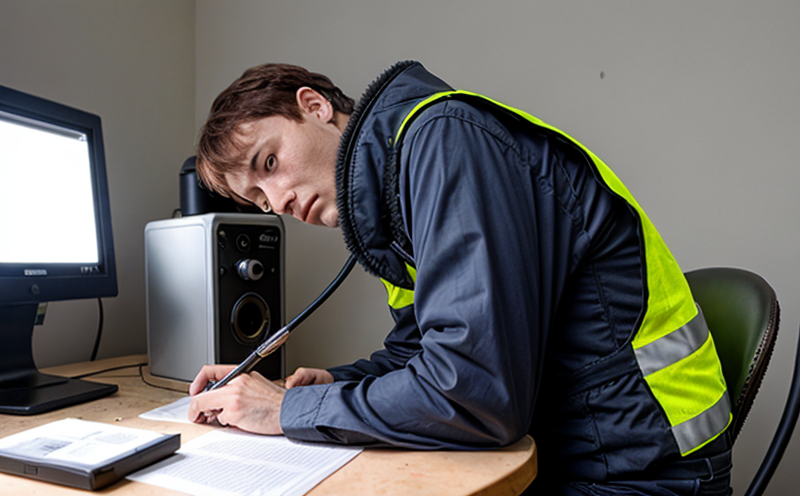ISO 17637 Visual Testing of Welds in Shipbuilding
The ISO 17637 standard specifies the requirements and guidelines for visual inspection of welds used in shipbuilding. This process ensures that welds meet design specifications, ensuring structural integrity and safety at sea.
Visual testing is a non-destructive examination (NDE) technique where welds are examined using the naked eye or with the aid of low magnification optical equipment. This method can detect surface irregularities such as cracks, incomplete fusion, lack-of-penetration, porosity, slag inclusions, and other visible defects.
The standard is crucial for shipbuilders because it establishes a consistent approach to weld inspection, promoting quality control and ensuring that all ships comply with international safety regulations. Compliance with ISO 17637 helps manufacturers meet the requirements of maritime authorities such as Lloyd's Register, ABS, DNV GL, and others.
The process involves several key steps: preparation of the weld surface, inspection by trained personnel using appropriate lighting conditions, and recording of any defects. It is important to note that visual testing alone cannot detect internal flaws; therefore, it is often used in conjunction with other NDE methods like ultrasonic or radiographic testing.
The standard provides detailed instructions on how to prepare the weld surface for inspection, including cleaning procedures to ensure a clear view of the weld. Proper lighting conditions are essential during the inspection process to minimize shadowing and maximize visibility. The inspector must use appropriate magnification tools if necessary and follow prescribed methods to document any defects found.
Compliance with ISO 17637 is not only about meeting regulatory requirements but also enhancing reputational capital within the industry. By adhering to this standard, shipbuilders can demonstrate their commitment to quality assurance practices, which ultimately leads to customer satisfaction and long-term relationships.
It's worth noting that while visual testing is a relatively simple process compared to other NDE techniques like ultrasonic or radiographic testing, it plays an indispensable role in ensuring the safety and reliability of welded structures. Its simplicity also makes it accessible to smaller shipyards where resources may be limited.
Industry Applications
- Metal fabrication industries focusing on high-strength steel components
- Automotive manufacturing for critical structural parts
- Aerospace and defense sector where precision is paramount
- Offshore oil and gas operations requiring robust infrastructure
The application of visual testing in shipbuilding aligns closely with these sectors due to the high-strength steel used and the critical nature of the structures involved. Compliance with ISO 17637 ensures that all welds are inspected thoroughly, reducing the risk of failures that could lead to catastrophic accidents.
By adhering to this standard, shipbuilders can ensure they meet not only regulatory requirements but also industry best practices. This contributes significantly to maintaining a high level of safety and reliability in maritime operations worldwide.
Eurolab Advantages
EuroLab offers comprehensive ISO 17637 visual testing services tailored specifically for the shipbuilding industry. Our experienced team ensures that all inspections are conducted according to the latest versions of international standards, including ISO 17637:2021.
We provide a range of services aimed at enhancing your production processes and ensuring compliance with relevant regulations:
- Pre-inspection surveys
- In-process monitoring during construction
- Final acceptance testing before delivery
- Detailed reporting and documentation for traceability
Our state-of-the-art facilities, combined with our skilled personnel, guarantee that every inspection is conducted efficiently and effectively. We understand the importance of timely results in a competitive market environment, so we strive to minimize downtime without compromising on quality.
At EuroLab, we also offer training programs for your staff to help them stay updated on best practices and latest technologies related to visual testing. This investment ensures that you have a knowledgeable workforce capable of maintaining high standards throughout your operations.
Use Cases and Application Examples
- Offshore Platforms: Ensuring the integrity of critical joints in offshore platforms is crucial for preventing accidents that could cost lives and cause environmental damage.
- Cargo Ships: Regular inspections help maintain the structural soundness of cargo ships, reducing maintenance costs while increasing operational efficiency.
- Retrofitting Projects: Visual testing plays a vital role in assessing the condition of older vessels undergoing modernization projects.
In addition to these examples, visual testing is also widely used during new construction phases where initial inspections are carried out before welding begins and final checks after completion. These steps ensure that all welds meet quality standards from start to finish.





